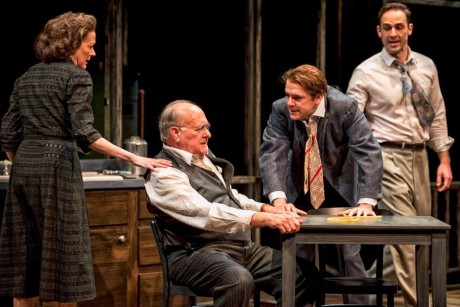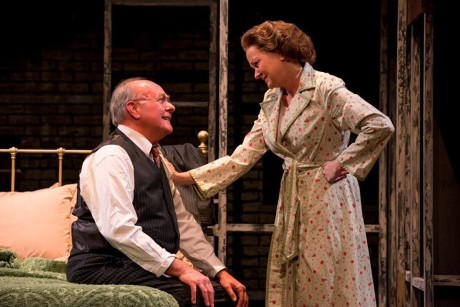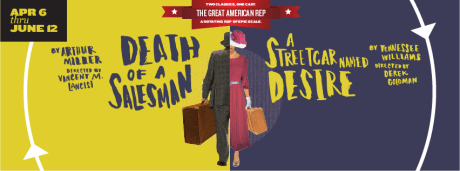In celebration of the 25th anniversary of its founding, Everyman Theatre is closing out its 2015-2016 season by doing something really special. After an already-impressive season of weighty pieces like August Wilson’s Fences and Michael Hollinger’s Under the Skin, Everyman has opted to take on the challenge of simultaneously producing Arthur Miller’s Death of a Salesman, and Tennessee Williams’ A Streetcar Named Desire. It is thought to be the first time ever that these plays have been performed together this way.

Here are two epic American classics and one exceptionally talented cast, with an accomplished Artistic Team capable of completely switching everything – sets and costumes, wigs and props, sound and lighting – between each of the performances. Usually, the shows will be alternating with Salesman one night, Streetcar the next. Eighteen times during the run, though, the actors and Artistic Team will be tackling both famed shows in one day: one for the matinee, the other in the evening. Happy birthday to you, Everyman! You never fail to impress me with your courage and vision.
Death of a Salesman is lauded as one of the best American plays of the 20th Century. With Miller’s smart, incisive writing and the graceful way he transports the audience from the here-and-now to inside Willy Loman’s thoughts, memories and dreams, that acclaim is is well-warranted. Everyman’s take on Miller’s masterwork is skillfully balanced. With a spartan set, unassuming costumes and subtlety in both lights and music, the focus necessarily goes to the actors and their dialogue-rich interactions.
Everyman Resident Company Member Wil Love is a powerhouse as beleaguered salesman, Willy Loman. From the moment Love’s feet hit the boards, we are all living in Willy’s world. Loman is commanding and magnetic, drawing his sons, his long-suffering wife, and all those around him into his sphere of gravity. Love sails the bleak ocean between Willy’s real life and the life he’d always imagined for himself. As Willy slips into and out of memories, fantasies, and reality, it would be tempting to play him as washed-up; a victim of an American Dream that was never really meant for him. Instead, Love portrays both the dignity and despair of this classic character, making him relatably human – and all the more tragic for it.
Loman’s wife Linda is played with stoic heroism by Resident Company Member Deborah Hazlett. She is the heart of her family, and its spine. She keeps the family standing upright and imbues it with a battle-hardened love. Hazlett brings Linda to life as a gifted tightrope walker. She keeps her footing despite watching her husband – who she truly loves – move from failure to failure, losing a bit more of himself every time. She keeps the household moving forward, taking care of logistical needs with insufficient resources. She demands that her sons treat their father with respect regardless of his diminished state and the shabby way he treats her. She is the postwar woman of the 1940s, toeing the line as a demure lady, yet as strong and solid as the house she cares for.
Though Chris Genebach, who plays Biff Loman, is not an Everyman company member, you’d never know it. His connection and chemistry with the other actors and the vulnerability he brings to his character would make you think he’d been working with these folks for ages. Genebach’s Biff struggles with a timeless dilemma. A “34-year-old boy,” he embodies uncertainty as he tries to decide whether he can live an authentic life he’d enjoy or if he must finally lash his fate to the ephemeral American Dream he sees destroying so many of his loved ones. Does he become the man his father wants him to be? It didn’t work out for his dad. Is he even capable of that? At a time when so many citizens are reconsidering what it means to be an American in the 21st century, Genebach hits all the right notes with this character who is as relevant today as when he first hit Broadway in 1949.
Biff’s brother Happy, played by Resident Company Member Danny Gavigan, is also wonderful to watch. He ably displays the internal tension that comes from loving Willy and Biff while also knowing that his relationship with them would always take a back seat to their relationship with each other. He’s a study in what we accept as fulfilling when what we really want is unavailable to us.
Resident Company Member Bruce Nelson worked double duty in Everyman’s Death of a Salesman. As Willy’s neighbor Charley, Nelson is aloof, but ultimately kindhearted. When Willy was down on his luck, Charley helped him without passing judgment or causing him shame. As Willy’s boss, Howard, on the other hand, Nelson is downright despicable. Howard is so out of touch with this worker – a man who had helped Howard’s father build the company that provided his life of privilege – that he is incapable of perceiving Willy’s suffering. Indifferent to Willy’s desperation, Howard dismisses his requests out-of-hand, prattling on instead about his latest toy, a recording device that cost the equivalent of nearly a month of Willy’s pay. Nelson portrays these characters’ differences with such aplomb that they would not have been more distinct had they been played by two different actors.
It’s not easy to make a complicated thing look simple. It takes a top-notch Artistic Team to create the environment these talented actors will inhabit. Set Designer Daniel Ettinger, for example, had to consider not only what were the best aesthetic and utilitarian choices for Death of a Salesman, he also needed to factor in the short changeover time available for switching the set to Streetcar and back. Ettinger handles this task admirably. The stark world he creates for Death of a Salesman works so well that you’d never suspect the set consists of giant puzzle pieces that, when reconfigured, will create the lusher, more homey set of the Tennessee Williams piece premiering next week.
The rest of the Artistic Team put their substantial talents to work, as well. Costume Designer David Burdick fitted the cast in era-appropriate, post-World War II attire. He selected a color palette for these costumes that underscored each character’s relationship with the themes of the play. For example, those faltering under the weight of an unattainable American Dream primarily wore muted grays. The few who were achieving some degree of success were more brightly or boldly attired. The Lomans’ neighbor Bernard (convincingly portrayed in both his teenage and his adult incarnations by Drew Kopas) was mocked by Willy and his sons for wearing lighter colors and more whimsical attire than they did. In the end, it was his hard work – not being well-liked or popular – that made him the financially and personally successful professional he became.
Like Burdick’s costumes, Harold Burgess’ lighting design and Chas Marsh’s sound design subtly and effectively underscored the action and the evolution of the characters’ feelings about ‘The American Dream’ and how to achieve it.
It’s not often you have the opportunity to recognize a Wig Designer in a theater review, so I’m taking my chance while I’ve got it. Denise O’Brien did such a fantastic job that when I read that 14 wigs were used in Death of a Salesman, I was shocked. That’s really the test of a good wig designer, right? To have their work incorporate so organically into the show that you don’t even realize it’s there? Well done.
Major kudos are due to Vincent Lancisi, who, as Founding Artistic Director of Everyman Theatre, was the architect of The Great American Rep. Additionally serving as Director of Death of a Salesman, he elicited outstanding performances from his cast. Lancisi should be proud of not just this first-rate show, but of founding a company that would make the joy and beauty of theater accessible not only to veteran lovers of the arts, but also to many who would not otherwise have the opportunity to experience professional theater.

With its exceptional design, direction, and pitch-perfect performances by its cast, Everyman Theatre’s riveting production of Death of a Salesman should be at the top of your ‘Must See List.’ Give yourself a gift to celebrate Everyman’s 25th birthday and pick up tickets to The Great American Rep. And here’s to another 25 years of Great Stories, Well Told.
Running Time: Approximately three hours, including one intermission.
Death of a Salesman plays in The Great American Rep with A Streetcar Named Desire through June 12, 2016 at Everyman Theatre – 315 West Fayette Street, in Baltimore, MD. Tickets can be purchased at the box office or online.





